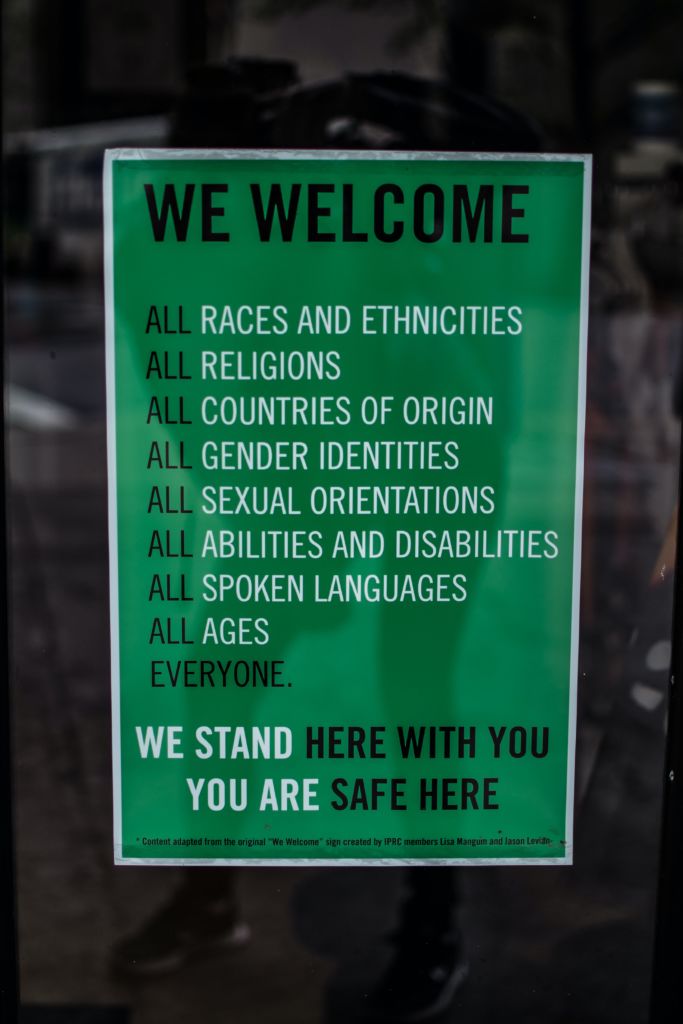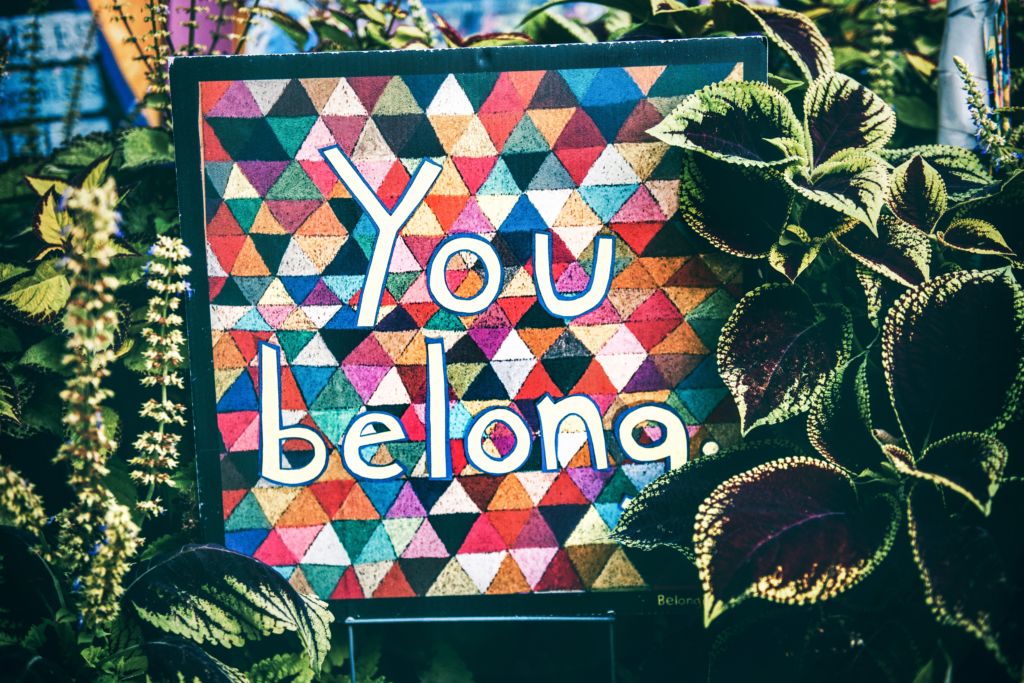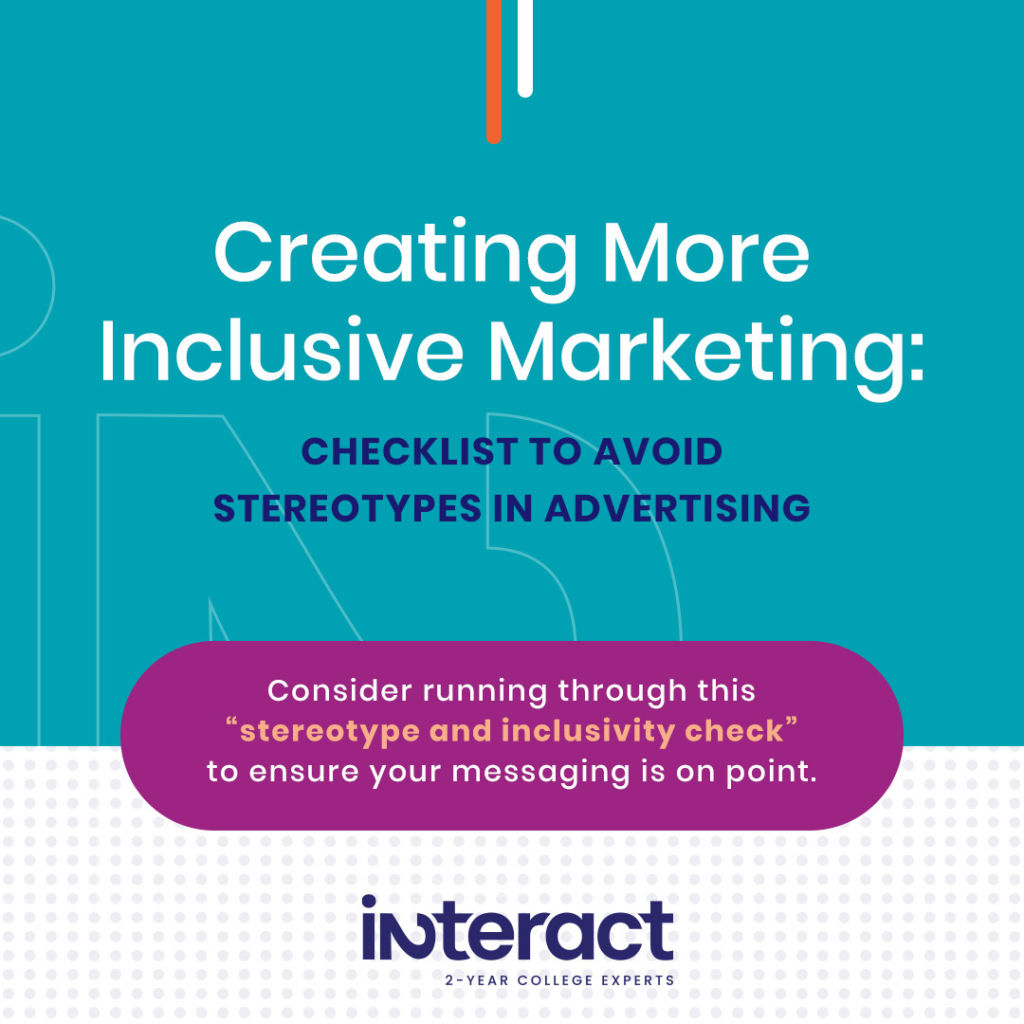Stereotypes in advertising can turn off audiences and turn away students. In this blog, company equity expert and Senior Director of Communications and Research Strategist Dr. Paula Di Dio breaks down advertising stereotype examples and offers solutions.
You’ll learn how to avoid canned cliches in marketing and find better alternatives. Plus, grab a free, helpful checklist to avoid stereotypes that you can use when launching a campaign.
But first, how to identify the problem:
What Are Examples of Advertising Stereotypes?
Stereotypes are widely held, fixed beliefs that convey an oversimplified idea or image about a particular person or group.
“There are two types of stereotypes,” write researchers Adam Galinsky and Maurice Schweitzer in Friend and Foe.
The first is descriptive stereotypes, which describe what a person or group is likely to do.
Second, prescriptive stereotypes are about what a person or group should do.
Prescriptive stereotypes and messaging can be harmful. Just take a look at these vintage gender stereotypes in advertising from the 1950s:
According to these messages, women MUST be pretty (but not clever), use the right deodorant (or risk losing their man), and ALWAYS be subservient housewives. And heaven forbid if a woman makes bad coffee!
It’s easy to laugh at how ridiculous these old gender stereotypes in advertising seem to a modern audience. But keep in mind that these advertisers were sincere at the time. Additionally, they probably didn’t have ill intentions when they created this sexist messaging. They were just woefully unaware that they had sublimated the biases of their times.
When marketers are unaware of their implicit biases and don’t research intended audiences, their messaging may not just fall flat. Gender stereotypes in advertising like these are offensive … and may end up on a YouTube reel of what not to do!
Why Are Stereotypes in Advertising Harmful?

When marketers leverage stereotypes, they risk generalizing and misrepresenting individuals or groups of people. Even seemingly “benign” gender stereotypes in advertising like “all women are nurturers” can perpetuate inequality, such as forcing women to be the default caregivers in their families.
Stereotypes lead to and reinforce prejudices. And prejudices create and uphold inequitable and oppressive structures.
Since community colleges are in the business of promoting equity, diversity, and inclusion, it’s critical to get your messaging in sync with your mission. And that means eliminating stereotypes in advertising.
Modern Examples of Stereotypes in Advertising Aimed at Hispanic Audiences

In our opening examples of stereotypes in advertising from the 1950s, it might be all too easy to shrug the faux pas off as old-fashioned. But stereotypes in advertising persist today, remaining a challenge for marketers in every industry.
Let’s take Hispanic audiences, who comprise over 45% of the college student population in some areas of California, Texas, Florida, and New York City. This demographic is of special interest to community college marketers, given the steep enrollment decline in this population.
More and more, marketing gurus have been offering advice on how to reach Hispanic audiences effectively. Yet, all too often, their suggestions have begotten tropes of Hispanic families, traditions, celebrations, and foods, which have populated thousands of pages of well-intentioned yet trite advice.
Unfortunately, it is all too easy for marketers in higher education to resort to these canned cliches in campaigns.
The Usual Stereotype Suspects
A recent article in the advertising trade magazine Adweek proclaimed the buying power of the Hispanic market and how to target this group more accurately. The article, sponsored by the Mexican American broadcast network TelevisaUnivision, was accompanied by a series of colorful and cheerful illustrations depicting the Hispanic world to a non-Hispanic audience.
As expected, these illustrations feature all the usual suspects regarding Hispanic stereotypes: a soccer player, a grandmother with a rolling pin, a dancing couple, and a man playing guitar. These made-to-order images and canned advertising suggestions perpetuate stereotypes that do not reflect the day-to-day life of the Hispanic consumer but rather a cliché of what is expected of them.
Below are some examples of common tropes from the Adweek article used to target Hispanic audiences that reinforce stereotypes:
Trope #1: Family

“For U.S. Hispanics, family is huge,” says Adweek. “An ad that digs deep into authentic, emotional storytelling about a father-son relationship can [engage your audience].” This publication goes on to state, “Look for specific moments that truly touch their hearts, and you can boost ad enjoyment and persuasion scores.”
–The Power of the U.S. Hispanic Consumer, Adweek
This kind of advice has been repeated ad nauseam by the so-called experts. However, is this “emotional storytelling” different from advertising to the general community?
It seems that this is just another stereotype. Far more effective would be taking the time to research a target audience to discover their real values and aspirations. (Keep reading for research tips to bust stereotypes in advertising!)
Trope #2: Escapism

The next trope to unpack is “escapism,” which came as a surprise. The article states that a tactic to appeal to Hispanics is “storytelling through a hopeful daydream, future fantasy, or even nostalgia.” This strategy would, according to the article, “grab Hispanic consumers’ attention and guide them into thinking about how your brand can serve their interests.”
This trope is insulting when you consider the definition from the Cambridge English Dictionary: Escapism is a “way of avoiding an unpleasant and boring life.”
Marketing and advertising should not judge people’s abilities to achieve a certain kind of life. Instead, it should help consumers become familiar with a product, service, or educational opportunity that might serve as an asset — not a prescription.
Ditch Stereotypes in Advertisements:
Top 4 Marketing Solutions for Diverse Audiences

When messaging is tone deaf …
Or communications do not meet your audiences’ needs …
Then your marketing campaigns will never help students enroll or persist.
To avoid harmful cliches in your marketing, start with solid research and build real diversity, equity, and inclusion:
1. Leverage Research to Eliminate Advertising Stereotypes

Unexplored biases can turn ugly when they translate into stereotypes.
We are all biased, but that’s not the bad news. The bad news is that most of the time, we are unaware of our implicit biases.
“Our brains are wired to tag people rapidly and not necessarily accurately in our interactions with others,” writes neuroscientist Gina Rippon in The Gendered Brain. She asserts that our innate wiring sorts others into “people like us” versus “people like them.”
For more about implicit biases, check out this video:
Culture plays a key role in forming our biases. Like fish, we may not even be aware of the waters we are swimming in. So, that’s why it’s important to conduct research early and often, uncovering any lurking biases that might translate into marketing stereotypes.
Qualitative and quantitative research can back up or debunk assumptions, uncovering the truth about the students you are trying to reach. Before any big marketing campaign, use focus groups and ethnographic research to understand your audiences’ social expectations. That way, you can adjust your messages to include those distinct perspectives. If you need real data for long-lasting results, Interact offers a suite of powerful research tools you can use to leverage your marketing.
2. Foster a Sense of Belonging

It doesn’t matter what walk of life you come from: We all want to experience a sense of belonging. And everyone needs to feel appreciated and acknowledged in our humanity, no matter our background or what kind of accent we have.
Likewise, students need to feel safe and have a sense of belonging. In order to communicate this core value, we must strengthen trust with our audiences. The best way to develop that trust is by walking alongside students and offering support as needed. Avoiding advertising stereotypes is just the first step. For long-lasting results, try doing some research.
Ask yourself and your team these questions, and use the answers as an institutional compass:
- Do your students across all demographics feel a sense of belonging in your institution? Do they feel welcome? Have you asked them — and have you asked them lately?
- How do you connect with different groups to keep them on track and engaged?
- What kind of community outreach do you have in place?
- What role do faculty members and counselors play in outreach efforts?
- Have you identified your most vulnerable populations? Are you following up with them regularly to ensure their academic and personal needs are met?
- Do you have a case-management approach for helping students in need?
- Do you have a mentorship program that might help students feel connected to the institution and their career goals?
When you offer a real sense of inclusion and trust on campus, it will come through authentically in your messaging.
3. Diverse Representation

Is your diverse student body represented among leadership, faculty, and staff?
Your marketing department can work day and night to bring students to the door. But, if learners don’t find teachers, mentors, and coaches who look like them and understand their unique needs, your messaging will fall flat.
Of course, you’ll want to highlight your diverse student body in your marketing materials to show prospects they belong on campus. But what happens on the first day of classes when their teachers don’t reflect that diversity?
When true representation is lacking, any ethnic, racial, gender, or linguistic difference translates into a power difference that will permeate every policy, decision, and interpersonal relationship.
No amount of marketing can make up for such a systemic imbalance. Changes like these take time, but they are worth the investment. If your college needs support in creating or implementing a plan, we can help: Sign up for a free consultation.
4. Always Do a Stereotype Check Before Running Campaigns [Grab Your FREE Checklist Here!]
Using predictable tropes, clichéd ideas, or canned cultural imagery to target populations will get old quickly. Don’t risk repelling instead of attracting diverse groups of students with advertising stereotypes. Instead, use our handy checklist to make sure your messaging is bias-free, inclusive, and welcoming.
Download Your FREE Checklist to Avoid Stereotypes

Let us know where to send your free checklist:




